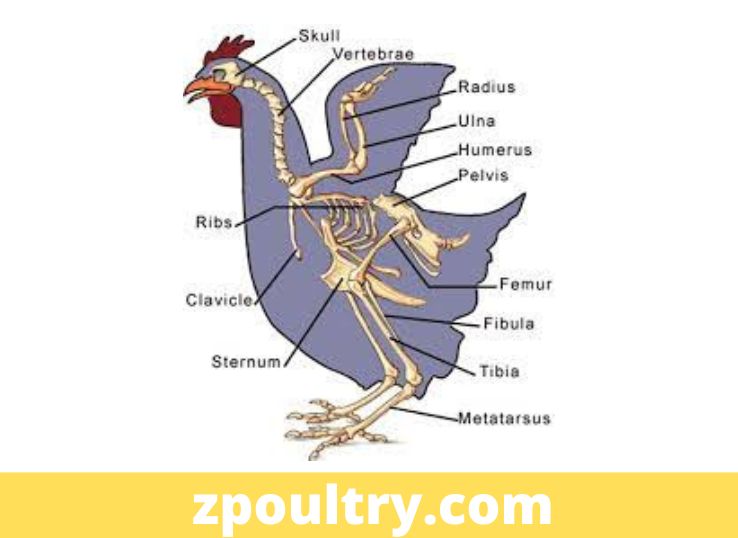Last Updated on July 4, 2023

The skeletal system of chickens is homologous to that of other animals. What makes this system special in many birds is the evolutionary changes leading to enhanced flying abilities. Although, chickens are unlikely to fly they have a similar skeletal system to that of other birds.
Just like every other vertebrate on the planet earth. The skeletal system is helpful in maintaining the upright body position. Additionally, it is crucial in calcium homeostasis & protecting the sensitive internal organs of chickens.
Due to their heavy body stature and weight, it is not possible for chickens to propel themselves upward. You might see them taking short flights because of the high muscle-to-bone ratio. However, the skeletal system is pivotal to keeping the body in shape and moving.
Table of Contents
ToggleAxial Skeleton of Chickens
Looking at the axial skeleton, chickens have 39 separate vertebras. These bones are further divided into sections such as cervical, thoracic, lumbar, sacral, and coccygeal. Chickens possess 13 cervicals, 7 thoracic, 14 fused lumbosacral, and 5 coccygeal vertebral bones.
The last thoracic vertebrae combined with lumbar, sacral, and coccygeal bones are present in the form of one group. This is due to close fusion to provide extra strength to the body of chickens. To establish a strong foundation for tail feathers, pygostyle is formed from a few last coccygeal.
Chickens have 7 pairs of ribs directed downwards from the thoracic vertebras. They are further divided into vertebral and sternal segments with uncinate processes connecting one rib to another. The breastbone is a quadrilateral plate with a backward projection known as Metasternum.
The sternal crest is present on the metasternum and is known as a keel in simple words. All of the major flight muscles such as pectoralis and subcontractor muscles have their insertion on the keel. The metasternum is by far the longest projection of the sternum in the form of cartilage.
The skull of chickens is composed of two regions as the cranium and the conical facial region. The eye orbits of chickens are a differential mark between the two said regions of the skull. Two small bones known as sphenoid and ethmoid separate the eye orbits whereas the cranium houses the brain.
The beak is formed by hard keratinized cells growing from the base just like nails. In chickens, the skull has a special bone beneath it known as the hyoid bone. Hyoid bone provides attachment to the tongue muscles and aids in the precise movement of the tongue in chickens.
Appendicular Skeleton of Chickens
The appendicular skeleton of chickens is mainly composed of wing bones and legs. The paired wing of chickens has a shoulder girdle region and an actual wing. The scapula, Coracoid, and Clavicle form the composition of the shoulder girdle in chickens.
The coracoid is known to be the strongest bone of the shoulder. It is attached to the sternum from one end and with a clavicle through the other. The scapula, on the other hand, is the shoulder blade of chickens but it is rather thinner and more curved unlike in mammals.
The clavicle is bent in appearance and attached to the coracoid and wing of the chickens. This bone acts as a shock absorber by the formation of a single structure known as Furcula in the midpoint. The Humerus is a rather strong and long bone like the arm bone of animals.
The thick and long bone of the forearm is known as the ulna in chickens. Whereas the thin and shorter radius. The thickness of these two bones is opposite to those of mammals. The hand of a chicken has a group of bones known as carpus, metacarpus, and digits.
The leg bones in chickens are divided into the pelvic girdle and the leg. The pelvic girdle is also known as the hip bone and is a single fused bone with three bones; Ilium, Ischium, and pubis. The leg region of chickens is composed of Femur, Tibia, Fibula, and Foot.
In chickens, the foot or pes of chickens contains a further three bones. The claw is made of tarsus, metatarsus, and digits. In the case of male chickens, a special projection known as a spur is also present on the medial aspect of the feet.
Why Skeletal System is Important in Chickens?
The skeletal system plays a multi-purpose role in the body of chickens. The importance of this system in providing structural support is of utmost importance. All of the bones work in coordination with the muscular system to enhance the mobility of the body.
Besides, the lightweight and compact skeletal system of chickens is a rich reservoir of calcium. Looking at the bones’ composition, one can have an idea of how well they are enriched in minerals. The main minerals are calcium and phosphorous which give strength to bones.
The skeletal system of chickens not only provides strength but also protection. Many of the bones such as ribs enclose the organs present in the chest cavity. Similarly, the skull provides protection to the brain and other bones offer support to body organs from accidental traumas.
Another important function of the skeletal system is to carry out erythropoiesis in chickens. Many of the bones have bone marrow inside the canals containing stem cells. These cells are specialized in the production of blood cells that are then released into the blood.

The Uniqueness of Chicken’s Skeletal System
Unlike mammals, the avian skeletal system is modified to some extent. To support flights, some sections of the backbone and ribs are fused together in birds. Similarly, the sternum is present in the form of a soft cartilaginous structure known as a keel to provide attachment to flight muscles.
Another important modification is the skull. Chickens and other birds have shorter skulls with beaks to provide less resistance and more aerodynamics during flights. Chickens do have tail bones but they are fused together to form a single bone known as pygostyle.
Chickens have longer necks resulting in more flexibility to support the skull from accidental shocks. Overall, the skeletal system of chickens is very rigid but the long neck is also helpful in balancing the chickens. Chickens have pneumatic bones where air sacs reside in long bone cavities.
Flight requires stability, and therefore, the ribs of chickens have uncinate processes. These structures are present in the form of overlying flaps to connect one adjacent rib to another. Uncinate processes have a role in giving collapse-proof support to the chest cavity of chickens.
Research References
Jacob, Jacquie, and Tony Pescatore. “Avian skeletal system.” Bulletin ASC-202, Cooperative Extension Service, University of Kentucky College of Agriculture, Food and Environment, Lexington, Kentucky. p 2 (2013).

I am a Veterinarian by profession having 3 years of experience in raising poultry flocks. So far my number of successful flocks is 9. I am sharing all my experience about poultry farming with you so that you can make this profession your bread and butter. Stay Tuned with my latest post.
